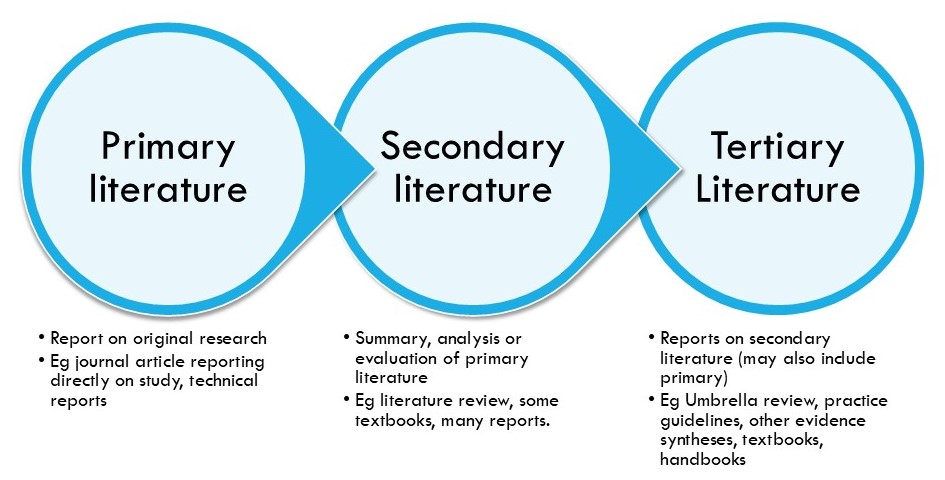Library Guides
- Library
- Library Guides
- The Literature Review
- Primary and secondary sources
Research literature can be considered primary, secondary or tertiary. Definitions of these varies between disciplines.
Primary research is original data or a firsthand account of something. In healthcare and science, the primary source of this is the journal article.
Secondary literature reports on primary sources. Examples include literature or systematic reviews, and many textbooks.
Tertiary literature reports on a combination of primary and secondary sources. Examples include encyclopedias, some textbooks and umbrella reviews ( or 'Reviews of Reviews').
Your literature review will be considered secondary literature (unless you report on other literature reviews, in which case it is considered tertiary).
In STEM disciplines we can think of it like this:

For more information, including social, humanities and arts subjects watch the video below.
|
Journal articles reporting research
|
Library databases – look for discipline specific databases first. Topics in humanities and social sciences may find multidisciplinary databases more useful. Google Scholar |
|
Reports |
Web search for likely organisations or government departments |
|
Policy documents |
Overton database. Web search |
|
Primary sources such as diaries, artworks, manuscripts |
TROVE – collections from Australian libraries, universities, museums, galleries and archives VU Special Collections – includes radical literature, particularly Australian Communist literature, women and urban planning, Timor-Leste, Western Melbourne Regional archive. |
|
Statistical data |
Many organisations provide data including UN Data, OECD Data, World Bank Open Data |
|
News reports |
News databases include current and archival content |
|
Indigenous material |
AIATSIS is the peak national body for the history, culture and heritage of Aboriginal and Torres Strait Islander Australia. Indigenous Studies Bibliography (AIATSIS) and |
Whether or not a source can be considered both primary and secondary, depends on the context. In some instances, material may act as a secondary source for one research area, and as a primary source for another. For example, Niccolò Machiavelli’s The Prince, published in 1513, is an important secondary source for any study of the various Renaissance princes in the Medici family; but the same book is also a primary source for the political thought that was characteristic of the sixteenth century because it reflects the attitudes of a person living in the 1500s.
Source: Craver, 1999, as cited in University of South Australia Library. (2021, Oct 6). Can something be a primary and secondary source?. University of South Australia Library. https://guides.library.unisa.edu.au/historycultural/sourcetypes
